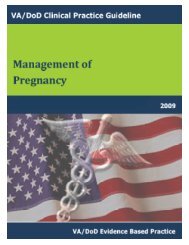DM Full Guideline (2010) - VA/DoD Clinical Practice Guidelines Home
DM Full Guideline (2010) - VA/DoD Clinical Practice Guidelines Home
DM Full Guideline (2010) - VA/DoD Clinical Practice Guidelines Home
Create successful ePaper yourself
Turn your PDF publications into a flip-book with our unique Google optimized e-Paper software.
Version 4.0<br />
<strong>VA</strong>/<strong>DoD</strong> <strong>Clinical</strong> <strong>Practice</strong> <strong>Guideline</strong><br />
for the Management of Diabetes Mellitus<br />
importance of not withholding insulin in those with type 1 <strong>DM</strong> as well as how to prevent, identify and treat<br />
hypoglycemia. Practitioners should be made aware of how to dose insulin with the various modes of nutrition and<br />
based on other factors that contribute to hyper or hypoglycemia such as changes in clinical condition and feeding<br />
status, and glucocorticoid use. Educational programs should emphasize that blood glucose data need to be analyzed<br />
daily and the treatment regimen adjusted to match changing insulin requirements.<br />
Nurses play a key role in every step involved with glycemic management and need to be regarded as leaders in<br />
inpatient diabetes initiatives. Early recognition of hyperglycemia, accurate performance of bedside blood glucose<br />
measurement, properly timed administration of insulin that is appropriately coordinated with meals, attention to<br />
changing nutrition or clinical condition, and prompt identification and treatment of hypoglycemia are just a few<br />
examples where nurses can play a critical role. Because nurses are front line providers of care, they must be<br />
included in the development and implementation of diabetes management programs and protocols; such<br />
collaboration is critical if these initiatives are to be successful.<br />
Medical nutrition therapy is an integral part of glycemic management and it is important to involve dietary experts<br />
in the planning of inpatient diabetes care. Insulin orders should be able to meet the specifications of dietary orders<br />
and often, physiologic insulin regimens such as basal-bolus approaches must be modified to address the complex<br />
nutritional status during hospitalization. For instance, regular insulin given every 6 hours may provide better<br />
coverage for patients receiving continuous enteral nutrition, and regular insulin might be added to total parenteral<br />
nutrition so that if the infusion is interrupted for any reason hypoglycemia can be prevented (Moghissi & Hircsh,<br />
2005).<br />
EVIDENCE TABLE<br />
Evidence Sources LE QE SR<br />
1 Documentation of known diabetes or The Joint Commission,<br />
III Poor I<br />
hyperglycemia in the medical record Working group consensus<br />
2 Blood glucose monitoring may<br />
facilitate identification of<br />
hyperglycemia and hypoglycemia<br />
3 Hospitalization and acute illness may<br />
increase the likelihood of adverse<br />
events<br />
4 Continuous IV insulin infusion is safe<br />
and most effective treating<br />
hyperglycemia in the ICU. Scheduled<br />
subcutaneous insulin regimens<br />
appear to be preferable to correction<br />
(sliding) scale insulin monotherapy.<br />
Hypoglycemia may be more common<br />
when total pre-hospitalization insulin<br />
dose is continued in the hospital.<br />
Meijering et al., 2006<br />
The Joint Commission<br />
III Poor I<br />
Working group consensus III Poor I<br />
Meijering et al., 2006<br />
Umpierrez et al., 2009<br />
Umpierrez et al., 2007<br />
Observational:<br />
Queale et al., 1997<br />
Golightly et al., 2006<br />
Schnipper et al., 2006<br />
Umpierrez et al., 2002<br />
I<br />
II-1<br />
Fair<br />
B<br />
Module G: Glycemic Control Page 74
















